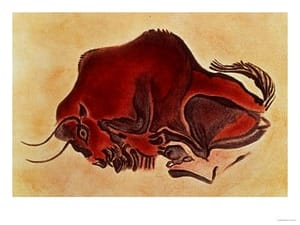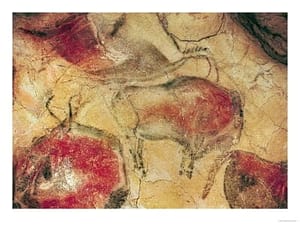I’d been meaning to pick up on earlier references to “the Caves of Altamira” for The Principles Of Moments website where we’ve been working on story.
I think this one comes from a different one, not sure of its provenance.
Just Google–ignoring Wikipedia for the moment, as I’m sure I’ll get back to it–we have Steely Dan doing said song. The images are a photomontage done by a fan.
Some map images here:
From this site,
we have the following text. [Bolding of text is mine.]
…There are three major sites containing cave paintings in Northern Spain which are presumed to have been painted by the Magdalenian people between 16,000-9,000 BC. Spanish archeologist Don Marcelino first discovered the caves at Altamira with their unique showcase of cave paintings. The paintings are located in the deep recesses of caves in the mountains of Northern Spain, far out of the reach of the destructive forces of wind and water. Thus these paintings have undergone little change from when they were first painted 11,000-19,000 years ago. The wall illustrations are not the only signs of human habitation here. Tools, hearths and food remains were preserved here for thousands of years. Altamira is the only site of cave paintings in which the signs of domestic life extend into the first cavern which contain the actual paintings. Oddly, the walls and ceilings of the Altamira caves lack the soot deposits which have been found in other similar caves. This might suggest that the people at Altamira had slightly more advanced lighting technology which gave off less smoke and soot than the torches and fat lamps which Paleolithic people are given credit for.
Back to “Paleolithic Period” Chronology
The paintings at Altamira primarily focus on bison. We can infer that bison were important because of the hunt. They were hunted primarily for the food they provided, but many other useful commodities like skin, bones and fur could be extracted from the remains of such a large animal. The ceiling painting is of 15 large bison with a few interspersed animals including a horse. The groups of animals portrayed, particularly those on the walls, are of bison, deer, wild boar, and other combinations which do not normally aggregate in nature. These pictures are of the animals only and contain no landscape or horizontal base.
What means did ancient peoples use to paint on the walls? The paints used for these creations were derived from natural earth pigments like ochre and zinc oxides. The paintings at Altamira boast of as many as three colors in the body of a single animal–a significant advance in technical skill over most cave artistry. This technical skill is further reflected in the accuracy of the physical proportions of depicted animals. Another advance in technical development at Altamira is that many of the animals are painted on natural protrusions from the rock face; most samples of cave painting ignore the natural character of the rock concentrating on only one dimension.
The paintings at Altamira are unique from other cave paintings in many ways. The technical skill of the Magdalenian people set the Altamira paintings apart from the rest. For they employed many different colors, where others used only one. They used the facets of rock to complement the animal design instead of painting a flat picture. They discovered more advanced lighting approaches. And finally, they were fortunate enough to have resided in caves so remote that all their hard work and creativity would remain unscathed for thousands of years. Archaeologists, historians, sociologists and students are just a few of the people who have learned more about ancient people through these masterpieces at Altamira.
Bibliography:
Hadingham, Evan, Secrets of the Ice Age: The World of the Cave Artists, (Walker and Company: New York, 1979)
Ucko, Peter J. and Rosenfeld, Andrew, Paleolithic Cave Art, (McGraw-Hill Book Company: New York, 1967.)…
edited to add:
as noted she would like traveling in Spain and Portugal, of course I’m also flashing back to classical guitar performances filmed at the Alhambra.
I’m not sure exactly why Gaudi’s work always reminds me of cave art as well. Something about the rounded forms and the rhythmic breaks, I think.
I’d love to see would be some of Gaudi’s more…friendly works. At one point I was fascinated with his architectural organic forms and looked up everything the library had on him. (Research geeks, hands up?)
Some of his pieces, I understand from some of the books you call coffee table size, with amazing pix, that some of his work is striking but very disturbing rather than attractive. Dark, schmoopy, unpredictable, like some of the jewelry insect designs by Louis Comfort Tiffany. More of that uncanny valley stuff…
So I thought I’d add some visuals on Gaudi here.
